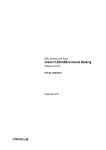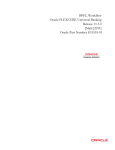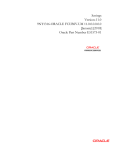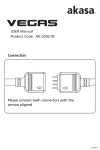Download Are You suprised ? - Oracle Documentation
Transcript
Procedures Version-1.0 9NT1425-ORACLE FCUBSV.UM.11.0.IN.1.0.0.0 [November] [2010] Oracle Part Number E51713-01 Document Control Author: Documentation Team Group: UBPG Created on: May 07, 2010 Revision No: Final Updated by: Documentation Team Reviewed by: Development/Testing teams Approved by: Software Quality Assurance Team Updated on: November 12, 2010 Reviewed on: November 12, 2010 Approved on: November 12, 2010 Procedures Table of Contents 1. ABOUT THIS MANUAL................................................................................................................................ 1-1 1.1 INTRODUCTION ........................................................................................................................................... 1-1 1.1.1 Audience ............................................................................................................................................ 1-1 1.1.2 Organization ...................................................................................................................................... 1-1 2. GETTING STARTED WITH ORACLE FLEXCUBE ................................................................................ 2-1 2.1 INTRODUCTION ........................................................................................................................................... 2-1 2.1.1 Changing your password ................................................................................................................... 2-2 2.1.2 Setting a reminder for password change ........................................................................................... 2-2 2.1.3 The procedure.................................................................................................................................... 2-2 2.2 THE APPLICATION BROWSER...................................................................................................................... 2-3 2.2.1 Menu .................................................................................................................................................. 2-4 2.2.2 Tasks .................................................................................................................................................. 2-5 2.2.3 Workflow............................................................................................................................................ 2-6 2.2.4 Customer............................................................................................................................................ 2-8 2.2.5 Unprocessed Alerts .......................................................................................................................... 2-11 2.2.6 The Horizontal Toolbar ................................................................................................................... 2-12 2.2.7 Icons and the functions they represent............................................................................................. 2-13 2.2.8 Main Menu....................................................................................................................................... 2-14 2.3 SOME COMMON ICONS AND THEIR USAGE ................................................................................................ 2-16 2.3.1 Adding and Deleting rows ............................................................................................................... 2-16 2.3.2 The Save and Exit Icons................................................................................................................... 2-17 3. COMMON OPERATIONS ............................................................................................................................ 3-1 3.1 INTRODUCTION ........................................................................................................................................... 3-1 3.1.1 Creating a product group ID ............................................................................................................. 3-1 3.1.2 Modifying or amending the group ID description ............................................................................. 3-2 3.1.3 Deleting a product group ID.............................................................................................................. 3-2 3.1.4 Closing a product group ID............................................................................................................... 3-2 3.1.5 Authorizing a product group ID ........................................................................................................ 3-3 3.1.6 Creating a new product ..................................................................................................................... 3-3 3.1.7 Deleting a product ............................................................................................................................. 3-3 3.1.8 Copying a product ............................................................................................................................. 3-4 3.1.9 Closing a product .............................................................................................................................. 3-4 3.1.10 Amending an existing product ........................................................................................................... 3-4 3.1.11 Authorizing a product ........................................................................................................................ 3-5 3.1.12 Retrieving information about a product............................................................................................. 3-7 3.1.13 Summary view of a product ............................................................................................................... 3-8 3.1.14 Detailed view of a product................................................................................................................. 3-8 3.2 ENTERING A NEW CONTRACT ...................................................................................................................... 3-9 3.2.1 Unlocking a contract ......................................................................................................................... 3-9 3.2.2 Amending a contract........................................................................................................................ 3-10 3.2.3 Deleting a contract .......................................................................................................................... 3-10 3.2.4 Copying the details of a contract ..................................................................................................... 3-11 3.2.5 Placing a contract on Hold.............................................................................................................. 3-11 3.2.6 Removing the Hold Status on a contract.......................................................................................... 3-12 3.2.7 Reversing a contract ........................................................................................................................ 3-12 3.2.8 Saving a contract ............................................................................................................................. 3-12 3.2.9 Authorizing a contract ..................................................................................................................... 3-13 3.3 AUTOMATIC AUTHORIZATION .................................................................................................................. 3-14 1-1 RETRIEVING INFORMATION ...................................................................................................................... 3-15 3.4 3.4.1 Contract Detailed View ................................................................................................................... 3-15 3.4.2 Viewing the Summary Details of a contract..................................................................................... 3-16 3.4.3 Confirming a contract...................................................................................................................... 3-17 3.4.4 Viewing the different versions of a contract .................................................................................... 3-17 3.4.5 Reassigning a contract to another user ........................................................................................... 3-17 3.5 MAINTAINING STATIC DATA .................................................................................................................... 3-18 3.5.1 Types of fields .................................................................................................................................. 3-19 3.5.2 Adding a new record in a table........................................................................................................ 3-20 3.5.3 Deleting a record in a table ............................................................................................................. 3-20 3.5.4 Copying the details of a record........................................................................................................ 3-20 3.5.5 Authorizing a record in a table........................................................................................................ 3-21 3.5.6 Modifying a record in a table .......................................................................................................... 3-21 3.5.7 Closing a record in a table .............................................................................................................. 3-21 3.5.8 Viewing the details of a record ........................................................................................................ 3-22 3.5.9 Maker and Authorizer Details ......................................................................................................... 3-22 3.5.10 Printing the details of a record........................................................................................................ 3-22 3.6 OTHER OPERATIONS ................................................................................................................................. 3-22 3.6.1 Changing the branch of operation................................................................................................... 3-22 3.6.2 Making a query ................................................................................................................................ 3-23 3.6.3 The procedure, with example........................................................................................................... 3-24 3.6.4 Making a query based on more than one criterion .......................................................................... 3-24 3.6.5 Selecting the same criterion to apply one or more conditions......................................................... 3-25 3.6.6 Ordering .......................................................................................................................................... 3-25 3.6.7 Using wildcards to make a query..................................................................................................... 3-26 3.6.8 Viewing Errors and Overrides......................................................................................................... 3-26 3.6.9 Viewing Customer Account Balance................................................................................................ 3-27 3.6.10 Viewing Customer Signature ........................................................................................................... 3-29 4. JOB SCHEDULING........................................................................................................................................ 4-1 4.1 INTRODUCTION ........................................................................................................................................... 4-1 4.2 DEFINING JOBS ........................................................................................................................................... 4-1 4.3 SCHEDULING JOBS ...................................................................................................................................... 4-4 4.3.1 Controlling Jobs ................................................................................................................................ 4-5 4.4 NOTIFICATION PROCESS ............................................................................................................................. 4-7 4.4.1 Viewing Notification Parameters..................................................................................................... 4-10 1-2 1. About this Manual 1.1 Introduction This manual is a step-by-step guide that tells you how to use the Oracle FLEXCUBE banking system. It details all the common procedures that can be followed while performing the various functions in the system. 1.1.1 Audience This manual is intended for the Customer Service Representatives (CSRs) and staff in charge of setting up new products in your bank. 1.1.2 Organization This manual is organized as follows: Chapter 1 About this Manual gives information on the intended audience. It also lists the various chapters covered in this User Manual. Chapter 2 Getting Started with Oracle Flexcube tells you can log into the Oracle FLEXCUBE system. Chapter 3 Common Operations explains the procedure to perform the most common operations while using the different modules in Oracle FLEXCUBE. Chapter 4 Job Scheduling explains the manner in which job schedulers schedule various jobs and the process of controlling the scheduled jobs. Conventions Used in this Manual Important information is preceded with the symbol. 1-1 2. Getting Started with Oracle FLEXCUBE 2.1 Introduction To get started, you need to log into the system. For this, you need to have a User ID and a password. The User ID is defined in the user profile created for you by your system administrator. When you invoke the system, you will see the ‘Sign-On’ screen. As soon as you launch this screen, a processing icon will be displayed. You need to wait for it to disappear before entering the following details: • User ID (the name through which you can access Oracle FLEXCUBE, as given to you by your system administrator) - This field is not case-sensitive. • Password – This field is case sensitive. • You can select a style for the Oracle FLEXCUBE appearance from the following options: • • Default • Sand Stone • Classic Click ‘Submit’ button. You will be logged in and the ‘Application Browser’ screen will be displayed if you have entered the correct User ID and password. If not, a message indicating that either the User ID or password is wrong will be displayed. 2-1 When your user profile is created, your password is automatically set to password. When you log in for the first time you will be forced to change your password only if the Force password change field has been checked in the User Profile Definition table. Your user profile will be disabled under the following circumstances: • The number of successive invalid login attempts defined for your user ID has been reached • The cumulative number of invalid login attempts defined for your user ID has been reached A message conveying that your user profile has been disabled will be displayed. The users designated as Control Clerks can enable your user profile for you to use again. If you want to exit the system, click exit icon. 2.1.1 Changing your password For reasons of security, you should change your password at regular intervals. 2.1.2 Setting a reminder for password change In the Bank Level Parameters table, (accessible to users designated as Control Clerks), it can indicated that a reminder or message be displayed a fixed number of days before a password change is due. For example, you can specify that a password change reminder be displayed three days before the change is due. If you specify accordingly, three days before the password change is due, you will see the reminder when you log into the system. This message will be displayed at every login until you change your password. You can change your password in two ways: • Your user password can be defined with a regular interval at which you should change your password. On the day the password change is due, the ‘Password Change for User’ screen will be displayed when you log in for the first time during the day. • You can also change your password, irrespective of the due date for change (specified through your user profile definition), using the Application Browser. ‘The Password Change for User’ screen will be displayed if you click on the ‘Change Password’ button of the menu bar or change password option of the menu by name ‘Options’ in the menu. 2.1.3 The procedure Your password should be entered in the ‘Password Change for User’ screen. It should then be typed twice over to confirm that your new password has been captured correctly. If the passwords do not match you a message will be displayed indicating that the passwords do not match. You will be prompted to repeat the process. 2-2 After making your entries correctly, click ‘Save’ button. Once your password has been changed, you will be logged out and you have to log in again using your new password. If you do not want to change your password, click ‘Cancel’ button. Remember the following while entering the new password: • New password should be different from old password. • Password should not have any blanks before it or after it. • Password should not have any spaces between the characters. • The only characters allowed for a password are: • • A to Z (in upper or lower case) • 0 to 9 numbers, and_ (Underscore) It should not be the same as n number of previous passwords defined in the Password Repetition field of the Bank Level Parameters table. (n stands for the number of previous passwords that cannot be used). Example At the Bank level the password repetition has been set to three. This means that your new password cannot be any of the last three passwords used by you. • 2.2 It should not be one of the passwords in the Restrictive Password list defined for your user profile, the role profile you are attached to (if there is any), or the Bank. The Application Browser When you log in using your user ID and password, the Application Browser on the left hand side bottom displays the following options: • Menu • Search Task • Workflow • Customer 2-3 2.2.1 Menu If you select ‘Menu’, you will be able to access the various Transaction screens, Queries, Maintenances etc. through this menu as per your user profile eligibility. To begin with, only the names of the modules are displayed. To go to a particular screen, position your mouse pointer to highlight the module and click on it. A list of functions available for that particular module will be displayed in an adjoining box. Click on the particular function, a list of sub-functions or options available for that particular function will be displayed in an adjacent box. Click on the option that you want to go to. The screen for the particular option will be displayed. If there are no options for a particular function, the function will be activated. Only those functions to which you have access rights in a module are displayed. If you do not have access rights to the module then the module is not displayed. When you invoke an existing record using the Browser, you cannot make modifications to it as the screen, which you have invoked, is in the view mode. In case you want to make modifications to a record, you should click on unlock button to unlock this record. This will enable you to make the desired modifications. When you click on the unlock button, you will observe all action buttons become disabled except the Save button. After you have made the required changes, click save icon to save your record. If you do not want to save the changes, click 'Exit' button. A message gets displayed. Do you want to cancel the operation? 2-4 Click OK to save and you will be returned to the ‘Application Browser’ or the screen from where you invoked this action without saving the changes. 2.2.2 Tasks If you select ‘Tasks’, you can perform the following actions: • Search • Standard View • Custom View If you select ‘Search’, the ‘Task Search’ window will be displayed on the right hand side: 2-5 Here you need to input the criteria for querying on the tasks. Click ‘Search’ button to initiate the query. Based on the details specified, the system will display all tasks satisfying the search criteria. If you select ‘Standard View’, the system will display the number of records available in each of the task queues viz ‘Pending’, ‘Assigned’, ‘Expired’ and ‘Completed’. The Pending List displays tasks which are not yet acquired by anyone. On acquiring, the task goes to the Assigned List. From the Assigned List, you can capture the task and input the action. Then the transaction goes to Completed stage. 2.2.3 Workflow If you select ‘Workflow’, you can view the number of records available in each of the workflow stages viz ‘Pending’, ‘Assigned’, ‘Failed’, ‘Unassigned’, ‘Asynchronous’, ‘Completed’, ‘Reversed’, ‘Tanked’ and ‘Untanked’. 2-6 You can also query on workflow stages by clicking on the ‘Search Tasks’ option. The ‘Workflow – Search’ window will be displayed on the right hand side. Here you can enter the details for querying on the workflow transactions. Click ‘Search’ button to initiate the query. Based on the details specified, the system will display all workflow transactions satisfying the search criteria. 2-7 The search results will display a summary of transactions heads with the list of transactions carried out under each head. You need to double-click on a transaction to invoke the corresponding screen. Based on the stage at which the transaction is and your access rights, you will be able to enter or modify data on the screen. 2.2.4 Customer If you select ‘Customer’, you can initiate a customer session. You will be able to query for a customer by entering all or few of the following details: Customer Name Specify the name of the customer whose details you wish to query. CIF ID Specify the customer identification number of the customer whose details you wish to query. Identifier Value Specify the identifier value of the customer whose details you wish to query. Click ‘Search’ button to initiate the query. Based on the details specified, the system will display all records satisfying the search criteria. 2-8 You can process multiple transactions for the same customer without having to key in the customer and account details every time. When you click on the hyperlink provided for ‘Customer Number’ in the screen above, the account details of the customer will be displayed in a separate screen along with the following customer details: • Customer Number • Branch Code • Customer Name • Customer Address • Birth Date • Unique Value, if any The system will list all the accounts created for the selected customer. The following account details are displayed on click of any Account no: • Account Number • Branch • Product Name – the type of account • Status – the date since when the current account status is effective • Available Balance • Current Balance 2-9 To set a customer for a session, click ‘Start session’ button. The following message is displayed: Do you want to set this Account Number and Details to the Session? Click ‘OK’ if you wish to process multiple transactions for the account. The system will display the following message to confirm the same: Customer session is opened for Account Number 100000001, Customer Number: DMP003IND The page also contains the customer’s Image (including those of other signatories of the account), if available, and the Operating Instructions etc. will be displayed, as shown below: 2-10 You can go through the signatory details and view all customer Photos and customer signature images using the Links ‘Prev’ and ‘Next’. If you set an account number and customer details for a session, you need not enter the Customer ID, Account and related fields for any transaction processed during the session. However, you can override the defaulted details by selecting a different Customer ID and/or Account for any transaction, at any point of time. 2.2.4.1 Ending a Customer Session To end a customer session, click ‘End session’ button in the customer search frame of the screen which will be displayed in place of ‘Start session’ button. The system displays a message to confirm the action. Click on ‘OK’ to proceed or ‘Cancel’ to continue with the same session. 2.2.5 Unprocessed Alerts If you select ‘Unprocessed Alerts’ system fetches all unprocessed alerts marked for the currently logged in user and displays it. 2-11 The user can view the unprocessed messages and select one or more messages by checking the adjoining checkbox and click ‘Process’ button. Once the message is processed the status is updated accordingly in the system. 2.2.6 The Horizontal Toolbar The horizontal toolbar features in most of the main screens. It consists of a set of icons, each associated with a function in the Main Menu. Icons provide shortcuts, which save you the effort of invoking functions, from the Main Menu. Only those icons for functions to which you have access rights will be enabled. The rest will be disabled. Whether the icons are enabled on the toolbar depends on the following factors: • The status of the record • Your access rights to different functions (toolbar related) • Functional set-up or the functional category (depending on maintenance/nonmaintenance functions). 2-12 2.2.7 Icons and the functions they represent Icons Function Description New Displays a record with no data so that you can enter data to create a new record. As soon as you click on this button, the ‘Exit’ button on a screen changes to ‘Cancel’ button. Copy Copies the details of the record on display on to a new record Save Enables you to save the new record/changes you have made on the record on display Delete Deletes the details from the record on display Unlock Unlocks a record enabling you to make changes Print Prints details of the record on display Close Closes a contract Re-open Re-opens a closed contract Reverse Reverses an authorized contract Template Saves a contract as a template Roll-over Rolls over or renews a contract Hold Places a contract on hold Authorize Activates the authorization function. Authorization has to be done by a user other than the one who has created or modified a record. Authorization is normally done during End of Day processing. Liquidate Activates the liquidation function Exit Exits the system Sign-off Enables you to sign-off without exiting the system. Throws up the Sign-on screen so that another user can sign-on Help Gives you the help on any field in the screen Add Adds a row to a grid in the screen Delete Deletes a row from a grid in the screen 2-13 Icons Function Description Option List Displays a list of values from a prior maintenance Confirm Confirms an action Since all these icons have their counterparts in the Main Menu, you can either click on these icons or activate the functions using the Main Menu. All actions are however, not applicable to all functions you can perform through a particular module. The action buttons, which are not relevant to a particular module, are disabled. A new record is not available for use till its creation is authorized by another user. Similarly, you cannot make any modification on a record till the previous modification, if any, has been authorized. As soon as you click any icon to initiate an operation, a processing icon will be displayed. You need to wait for it to disappear before entering details in the corresponding screen. 2.2.8 Main Menu You can see the following menu options: • Actions • Operations • Options • Windows • Help 2.2.8.1 Actions The following actions are available under ‘Actions’: • New • Copy • Unlock • Hold • Save • Close • Reopen • Delete • Authorize 2-14 • Print • Sign-off • Exit 2.2.8.2 Operations The following operations are available under ‘Operations’: • Confirm • Liquidate • Rollover • Reverse 2.2.8.3 Options Under ‘Options’ the following tasks are available: • Enter Query • Execute Query • Cache • Debug Mode • Debug Window • Hot Key • Change Password • Change Branch 2.2.8.4 Help Under ‘Help’, the following options are available: • Accessibility • Oracle FLEXCUBE Help • About On selecting ‘Accessibility’ the following screen is displayed where you can see the access keys and the hot keys for the application. 2-15 2.3 Some common Icons and their Usage There are some icons, which represent functions that are common across all modules of Oracle FLEXCUBE. 2.3.1 Adding and Deleting rows The Add row and Delete row icons are used when you have to enter or fill up rows of data in a screen. Let us take the example of the ‘CLS Currency Restrictions’ screen in the Customer Maintenance module. You have to add various currencies to the list of restricted currencies. To do this, you will first choose the Currency from the option list. Both currency and description will get populated. Example Now the first row is complete. Click add icon. This will save the data in the first row and take you to the next row. 2-16 Suppose you realize that you have allotted the wrong currency and you do not want to save the data in the first row. Click delete icon. The data will not be saved in the row and you can fill it with the correct data. 2.3.2 The Save and Exit Icons • After you have entered data in a screen you may want to save the data. Click ‘Ok’ button. • If you do not want to save the data in a screen, click ‘Exit’ or ‘Cancel’ button to return to the Application Browser. To exit from a screen, click ‘Exit’ or ‘Cancel’ button to return to the Application Browser. 2-17 3. Common Operations 3.1 Introduction Help topics are available for some of the operations that are common to most modules in Oracle FLEXCUBE and can be performed on: • Product • Contract • Record in a table Besides these, some other operations like changing your branch of operation; viewing different versions of a contract; reassigning a contract to different users; static data and its maintenance; types of fields; and making a query on the ‘Contract On-line Summary’ screen are also discussed. As soon as you launch any screen, a processing icon will be displayed. You need to wait for it to disappear before entering details. 3.1.1 Creating a product group ID From the Application Browser, click on your module name, (for example, Funds Transfer, Data Entry, Loans etc.,). All the operations for which you have access rights for the module will be displayed. Click on Product Group and on Detail under it. Select ‘New’ from the Actions menu in the Application tool bar or click new icon. The ‘Product Group Definition’ screen will be displayed without any values. In the ‘Product Group Definition’ screen, enter a unique Group ID (an ID for which no record has been opened). Give it a description and then save the record by selecting ‘Save’ from the Actions menu in the Application tool bar or by clicking save icon. Click ‘Exit’ or ‘Cancel’ button to go back to the Application Browser. If automatic authorization has been enabled for the product group maintenance function, as well as the logged in branch, profile of the user who is saving the record, and the user also has rights for both input and authorize operations, the record will be automatically authorized when the Save operation is performed. After you save the Product Group ID, your user-ID will be displayed at the ‘Input By’ field and the date and time at which you saved the product will be displayed at the ‘Date Time’ field. At this point, the Product Group ID is still unauthorized. It will be available for use only after it has been authorized by a user other than you. 3-1 3.1.2 Modifying or amending the group ID description The description of a Group ID can be modified even after it has been authorized. Select ‘Unlock’ from the Actions menu in the Application tool bar or click unlock icon: • When the Group-ID is highlighted in the Product Group Summary View • When the Group ID is displayed in the Product Group Detailed View Change the description and save it by selecting ‘Save’ from the Actions menu in the Application tool bar or by clicking save icon. A user other than you should authorize the modification. If automatic authorization has been enabled for the product group maintenance function, as well as the logged in branch, profile of the user who is saving the record, and the user also has rights for both input and authorize operations, the record will be automatically authorized when the Save operation is performed. 3.1.3 Deleting a product group ID You can delete a Group ID only before it has been authorized. When you delete a Group ID, it is removed from the system completely. It will not be available to you for future use. You need to define it again, if you need it. Select ‘Delete’ from the Actions menu in the Application tool bar or click delete icon. • When the Group ID is highlighted in the Summary View • When it is displayed in the Detailed View You will be prompted to confirm the deletion. If you cannot delete a Group ID you can close it. 3.1.4 Closing a product group ID You cannot delete a Group ID once it has been authorized. However, you have the option of closing it. A closed Group ID will not be available to you for use, although it will remain in the system. A Product Group ID can be closed only under the following circumstances: • It should not have any Products linked to it. (A product, which has active contracts involving it cannot be closed. Only when all the contracts involving the product are liquidated can the product be closed. Only when such products are closed can a group be closed). • It should have been authorized for the last activity that was performed on it. Select ‘Close’ from the Actions menu in the Application tool bar or click close icon: • When the Group-ID is highlighted in the Summary View 3-2 • When it is displayed in the Detailed View You will be prompted to confirm the closing. 3.1.5 Authorizing a product group ID A Group ID should be authorized by a user other than you (if it has been initiated by you) before it is available for use. Modifications to the Group ID have to be authorized before they take effect. Select ‘Authorize’ from the Actions menu in the Application tool bar or click authorize icon: • When the Group ID is highlighted in the Summary View • When it is displayed in the Detailed View You will be prompted to confirm the authorization. 3.1.6 Creating a new product From the Application Browser, click on the relevant module name like Data Entry, Funds Transfer, Loans etc. All the operations for which you have access rights for the module will be displayed in an adjoining box. Click on Product Group and Detail under it. Select ‘New’ from the Actions menu in the Application tool bar or click new icon. The ‘Product Group Definition’ screen will be displayed without any values in the fields. Enter the details of the record in the respective fields and click save icon. If automatic authorization has been enabled for the product definition function, as well as the logged in branch, profile of the user who is saving the record, and the user also has rights for both input and authorize operations, the record will be automatically authorized when the Save operation is performed. 3.1.7 Deleting a product You can delete a product that has been created, prior to its authorization. To delete the unauthorized details of a product: Select ‘Delete’ from the Actions menu in the Application tool bar or click delete icon when you are in ‘Product Detailed View’. You will be prompted to confirm the deletion. If you want to go ahead with the deletion, click ‘Yes’ button from the message window that pops up. When you delete a product the details of the unauthorized product are removed from the system. If you do not want to delete the product, click ‘No’ button in the message box. You will be returned to the Product Detailed View and the product details will not be deleted. 3-3 3.1.8 Copying a product Often, you may have a situation where you need to create a product that closely resembles an existing product. In such a case, instead of entering all the details for the product, you can copy the details of one product on to another, changing only those attributes that are different for the new product. To copy the details of a product from the Product Detailed View, select ‘Copy’ from the Actions menu in the Application tool bar or click copy icon. All the attributes of the old product, barring the Product Code, will be copied. You will be prompted to enter a new Product Code. Enter the Code and click on save icon. You can make relevant changes to the fields that have had the inputs copied on to them from the old product and you can again save your new product. 3.1.9 Closing a product You cannot delete a product once it has been authorized. However, you have the option of closing it. A closed product will not be available to you for use, although it will remain in the system. A product can be closed only under the following circumstances: • It should not have any contracts linked to it. (A product, which has active contracts involving it, cannot be closed. Only when all the contracts involving the product are liquidated can the product be closed). • It should have been authorized for the last activity that was performed on it. Select ‘Close’ from the Actions menu in the Application tool bar or click close icon: • When the product is highlighted in the Summary View • When it is displayed in the Detailed View You will be prompted to confirm the closure. If you want to go ahead with the closure, click ‘Yes’ button from the message window that pops up. If you do not want to close the product, click ‘No’ button in the message box. 3.1.10 Amending an existing product Certain attributes of an authorized product can be changed depending on whether a contract has been input for the product: • If no contracts have been input for the product, you can amend the inputs to any of the fields. • If contracts have been input for the product (even if all of them have been liquidated) you can amend only those attributes that do not affect the financial information of a contract. The changed attributes will be applied to all contracts that are entered or rolled over after the amendment is authorized. 3-4 To amend a product: • Choose Unlock from the Actions Menu in the Product Detailed View • By clicking unlock icon in the Application tool bar. The latest version of the product will be displayed and you can make the changes to the inputs. Save the changes by: • Clicking on save icon in the Application tool bar. • By choosing ‘Save’ from the Actions Menu All the validations that were done when you created the product will be carried out again by the system and error messages and override messages will be displayed. The modification will be displayed in the ‘Modification No.’ field of the audit trail. If automatic authorization has been enabled for the product definition function, as well as the logged in branch, profile of the user who is amending the record, and the user also has rights for both input and authorize operations, the record will be automatically authorized when the Save operation is performed. After the amendment is stored, your User-ID will be displayed at the Input By field. The date and time at which you saved the product will be displayed at the Date/Time field. The Status of the product will be shown as unauthorized. The changes to the product have to be authorized before you enter a contract for it. The version of the product with all the changes you made in this session will be the latest version. If you click delete icon in any of the screens, you will see a message that will prompt you to confirm whether the changes have to be saved. You can choose to do one of the following: • Save the changes by clicking ‘Yes’ button in the message • Not save the changes by clicking ‘No’ button in the message • Click ‘Cancel’ to get back to the screen from where you selected ‘Unlock’. 3.1.11 Authorizing a product The creation and modification of a product should be authorized before it can be used to input a contract. To authorize the details of a Fixed Assets Product, from the ‘Fixed Assets Product Definition’ screen: • Click authorize icon on the Toolbar • Select ‘Authorize’ from the Actions Menu Remember that you cannot authorize an event that was input by you. It should be done by another user who has access rights for authorization. 3-5 If you are authorizing changes, the new value and the old value of the fields will be displayed. The ‘Authorization’ screen will be displayed with the modification number. Click ‘View Changes’ button to view the changes done on the record. Check the records to be authorized and then click on ‘Ok’ button to confirm the authorization. Your User-ID, the date and the time at which you did the authorization will be displayed in the Maker ID and Maker Date Stamp fields at the top of the screen. The Status of the record will be updated as authorized. Click ‘View Changes’ button to view the modification. The following screen will be displayed. 3-6 The changed details will be highlighted. Click ‘Exit’ button to go back to ‘Authorization’ screen. Select the modification that needs to be authorized and click ‘Ok’ button to authorize the transaction. If you do not want to confirm the authorization, click ‘Exit’ button. You will be taken back to the Tax Summary View. The record will not be authorized. 3.1.12 Retrieving information about a product The details about a product can be retrieved either as a display or in print. The details are available in two forms: • The Product Summary View gives a list of the attributes of all the products • The Product Detailed View gives you all the attributes about a specific product You can print the details of a product from any of these screens. 3-7 3.1.13 Summary view of a product You can go to the Summary View by highlighting the module name in the Application Browser; all the functions associated with that module will be displayed in an adjoining box. Similarly highlight a function, the options (Detailed or Summary) available for the particular function will be displayed in an adjacent box. Click on Summary, the ‘Summary View’ screen is displayed. The following attributes of all the products will be displayed in the Summary View: • Product Code • Description • Group (Product) • Start Date • End Date • Record Status (Open/Closed) • Authorization Status (Authorized/Unauthorized) To begin with, the information will be sorted on the Product Code, in the ascending order. You can choose to sort it on any of the attributes that are displayed. Please remember that except for print you cannot perform any operation on a product while you are in the ‘Summary View’ screen. From the Summary View you can go to the ‘Product Detail View’ screen by double clicking on the required record. To go back to the screen from where you invoked the Product Summary View, click ‘Exit’ button. 3.1.14 Detailed view of a product You can retrieve information about all the attributes of a product through the Product Detailed View. To view the details of the product, click on the respective icons. The status of the product will be indicated along with the details. From the Product Detailed View, you can choose to do the following operations: • Input a new product • Amend the product whose details are being displayed • Delete the product whose details are being displayed, if it is unauthorized • Copy the details of the product that is being displayed onto a new product • Authorize the product that is being displayed, if it is unauthorized • Print the details of the product that is being displayed 3-8 You can carry out any of these operations by choosing them from the Actions Menu or from the Toolbar. For example: To input a new product: • • • • • Input a new product by highlighting the product, and: • Clicking new icon in the Toolbar • Choosing 'New from the Actions Menu Authorize a product, by highlighting the product and: • Clicking authorize icon in the Toolbar • Choosing Authorize from the Actions Menu Close a product by highlighting the product, and: • Clicking close icon in the Toolbar • Choosing Close from the Actions Menu Copy the details of one product onto another by highlighting the product, and: • Clicking copy icon in the Toolbar • Choosing Copy from the Actions Menu Print the details of one product onto another by highlighting the product, and: • Clicking on print icon in the Toolbar • Choosing Print from the Actions Menu Click ‘Exit’ button to go back to the screen from where you invoked the Product Detailed View. 3.2 Entering a new contract To input a new contract in the ‘Contract Details’ screen: • Select New from the Actions Menu • Click on new icon in the Toolbar 3.2.1 Unlocking a contract If you want to change the details of an Authorized Contract you can open the record by: • Click unlock icon in the Toolbar • Choosing Unlock in the Actions Menu A record that is unlocked by a user cannot be opened by any other user. 3-9 3.2.2 Amending a contract You can amend certain details of a contract depending upon its authorization status: • When you have captured the details of a contract and it is yet to be authorized for the first time you can change all its attributes - financial as well as non-financial, even if the details have been saved once. If accounting entries are involved in the change, the old entries are deleted and new ones passed. • Once a contract has been authorized, changes can be made only to the non-financial details of the contract, or the details that do not affect the accounting entries passed by the system. From the Detailed View: • Choose Unlock from the Actions Menu • Click on unlock icon in the Toolbar Make your amendments and save them. If you do not wish to save changes, exit the contract. It will retain the old values. If automatic authorization has been enabled for the contract function, as well as the logged in branch, profile of the user who is saving the amended contract record, and the user also has rights for both input and authorize operations, the record will be automatically authorized when the Save operation is performed. For each amendment, a new version of the contract will be generated. 3.2.3 Deleting a contract You can delete a contract that has been: • Input and stored, stored, but yet authorized • That has been put on hold • That has been modified but not authorized The Contract Detailed View: • Select Delete from the Actions Menu • Click delete icon in the Toolbar. You will be prompted to confirm the deletion. Once you confirm it, all the entries that have not been authorized will be deleted. 3-10 3.2.4 Copying the details of a contract Often, you may have a situation where you need to create a contract that closely resembles an existing one. In such a case, instead of entering all the details for the contract, you can copy the details of one contract on to another, changing only those attributes that are different for the new contract. From the Contract Detailed View you can copy the details of a contract onto a new one. To copy a contract either: • Click copy icon in the Toolbar. • Select Copy from the Actions Menu. When you copy a contract: • A new Reference Number will be allotted to the contract • The User Reference field will default to the Contract Reference number • The Contract Start Date will be given a value of today and the Contract End Date will be left blank After you have made the relevant changes to the fields that have had the inputs copied on to them from the old product you can save your new product. To Save either: • Click save icon on the Toolbar • Choose Save from the Actions Menu 3.2.5 Placing a contract on Hold There may be a situation where you do not have the complete details of the contract you are entering. In such a case you can enter the details you have on hand and place the contract on Hold instead of saving it. You can perform this operation from the Contract Detailed View. You need not authorize a contract that is on hold. During information retrieval, such a contract will be reported as Held. To put a product on Hold either: • Click hold icon on the Toolbar • Choose Hold from the Processing sub-menu of the Actions Menu No accounting entries and advices will be generated for a contract on Hold and the incomplete contract details will remain in the system. When all the details of the contract are available, you can lift the Hold status on the contract and process it like any other contract. 3-11 3.2.6 Removing the Hold Status on a contract When all the details of the contract are available, you can remove the Hold status on the contract by either: • Selecting Unlock from the Actions Menu. • Clicking unlock icon in the Toolbar. After you have unlocked a contract put on Hold you can enter the necessary details and process the contract like any other contract. 3.2.7 Reversing a contract Using the Contract Reversal function you can reverse out an authorized contract. Typically, you would use the contract reversal function, if the details of an authorized contract are erroneous. All accounting entries that were passed for the original contract will be reversed. The limits utilized by the original contract will be released. The Contract Detailed View: • Select Reverse from the Processing sub-menu of the Actions Menu, or • Click reverse icon in the Toolbar You will be prompted to confirm the reversal. Once you confirm it, all the accounting entries that have been passed for the contract will be reversed (this is done by passing the entries with a negative sign). These entries could be the contract initiation entries or any liquidation entries (interest, tax, etc.). After the reversal has been done, you will be returned to the ‘Contract Detail View’ screen. 3.2.8 Saving a contract To save a contract after having captured its details, made modifications, copied it, etc. either: • Click save icon in the Toolbar • Choose Save from the Actions Menu If automatic authorization has been enabled for the contract function, as well as the logged in branch, profile of the user who is saving the contract record, and the user also has rights for both input and authorize operations, the record will be automatically authorized when the Save operation is performed. 3-12 3.2.9 Authorizing a contract Any operation on a contract - input, copying, modification, value-dated changes, manual liquidation, rollover, reversal, etc., - has to be authorized by a user other than the one who performed the operation. All the contracts should be authorized before End of Day operations can begin. A contract on Hold does not need authorization. From the Contract Summary View (when the contract is highlighted), or the Contract Detailed View (when the contract details are displayed), you can invoke the ‘Contract Authorization’ screen either by: • Choosing Authorize from the Actions Menu • Clicking authorize icon in the Toolbar If the contract involves a product for which some Re-key fields have been defined, the details of the contract will be displayed only after you input the values in those fields. If no Re-key fields have been defined, the details of the contract will be displayed in the ‘Authorization’ screen. All the overrides that were given during the operation will be displayed when the contract is being authorized. If you are authorizing an amendment, the old values are replaced by the amended values, which will be available for subsequent processing. 3-13 The old values, however, will still be available in an earlier version of the contract. Click on ‘Ok’ button to authorize the contract. Click on ‘Exit’ button if you do not want to authorize the contract. After the contract has been authorized, the accounting entries passed during this stage will also be marked as authorized and advises, if any have been specified for the operation, will be generated. You will be returned to the screen from where you invoked the ‘Contract Authorization’ screen (Contract Summary View or Contract Detailed View). The audit trail of the screen will display the following details: 3.3 • User ID of the person who input/modified contract details – ‘Input By’ field • Date and time of data input – ‘Date Time’ field • User ID of the person who authorized contract details – ‘Authorized By’ field • Date and time of authorization – ‘Date Time’ field • Contract Status (Open or Closed) • Authorization status – Authorized or not Automatic Authorization If automatic authorization has been enabled for a function, branch and user profile, and such a user has rights for both input and authorize operations, any record maintained by such a user in the corresponding function (maintenance or online) screens will be automatically authorized when the Save operation is performed. When automatic authorization takes place, • The authorization screen is not opened. Authorization is considered as full or complete authorization, which would mean that all unauthorized changes to the record would be authorized. • The re-key fields configured for authorization in respect of the function are not required to be entered by the user. • Messages in respect of overrides are not displayed, but are internally authorized. Similarly, overrides requiring confirmation are also automatically confirmed. • Any applicable online message are generated and displayed. The user can respond based on the error type – For ‘Ignore’ error types, the system automatically generates the messages; for ‘Override’ error types, the user is prompted about whether message generation is required; for ‘Error’ error types, messages are not generated. • The user’s authorization limit is checked when automatic authorization takes place • The maker/ checker validation is not performed when automatic authorization takes place 3-14 3.4 Retrieving information The details of a contact can be retrieved either as a display or in print. The details are available in two forms: • The Contract Summary View gives a gist of the attributes of all the contracts under various products • The Contract Detailed View gives you all the attributes about a specific contract From any of these screens, you can print the details of a contract. 3.4.1 Contract Detailed View You can retrieve information about all the attributes of a contract through the Contract Detailed View. To view the details of a contract from the Contract Summary View you can double click on the contract or choose Detailed from the View Menu. The status of the contract is displayed along with the authorization details. From the Contract Detailed View, you can choose to do the following operations: • Input a new contract • Amend the contract whose details are being displayed • Delete the contract whose details are being displayed, if it is unauthorized • Copy the details of the contract that is being displayed onto a new contract • Authorize an operation on the contract being displayed • Print the details of the contract that is being displayed • Close and Re-open a contract that has been authorized • Process the contract. Thus, you can: • Reverse a contract. That is, reverse out its accounting entries • Roll a contract over if it has been defined with manual rollover • Record counterparty confirmation for a contract • Liquidate some components of a contract • Hold a contract if you do not have its complete details You carry out any of these operations by choosing them from the Actions Menu, (the Processing sub-menu for the processing functions) or from the Toolbar. To input a new contract either: • Select New from the Actions Menu 3-15 • Click new icon in the Toolbar Click ‘Exit’ button to go back to the screen from where you invoked the Contract Detailed View. 3.4.2 Viewing the Summary Details of a contract To go to the Summary View you can highlight the module name in the Application Browser, all the functions associated with that module will be displayed in an adjoining box. Similarly highlight a function, the options (Detailed or Summary) available for the particular function will be displayed in an adjacent box. Click on Summary, the ‘Summary View’ screen is displayed. If you are in the Contract Detailed View, choose Summary from the View Menu. Typically, the following details of all contracts will be displayed: • Branch • Reference Number • Counterparty • Contract Amount • Currency • Value Date • Maturity Date • Product • User Reference Number • Related Reference Number • Status • Payment Method • Rate Code • Rate Spread • Interest Amount When you invoke this function, all the contracts will be displayed. The unauthorized contracts, the liquidated ones and those on Hold will be displayed. To begin with, the contracts will be sorted on their product codes (alphabetical order of the product code). You can choose to sort them on any of the fields displayed. To view all the details of a contract, do one of the following: • Double click on the contract • Choose Contract Detailed View when the contract is highlighted 3-16 3.4.3 Confirming a contract Events on certain types of contracts like money market or foreign exchange contracts need to be confirmed by the counterparty or the broker. For example, if a money market placement is initiated an advice is sent to the counterparty along with a confirmation slip. Upon receiving the confirmation slip, duly signed by the counterparty or the broker, you can confirm the deal. Invoke the contract that has to be confirmed. Click on the Actions Menu on the main menu bar. Click on Confirm under processing to confirm the contract or the event on the contract. 3.4.4 Viewing the different versions of a contract When you are in the Contract Detailed View, you can view the different versions by clicking on the following buttons: Button Function To move to previous version of the record To move to next version of the record To move to first version of the record To move to the last version of the record These buttons are specific to certain modules of Oracle FLEXCUBE only. You can also click on the following options under View in the Main Menu: • Move First (to move to the first version of the record) • Rewind (to move backward until you find the version you are looking for) • Move Previous (to move to the previous version of the record) • Move Next (to move to the next version of the record) • Fast Forward (to move forward until you find the version you are looking) • Move Last (to move to the last version of the record). 3.4.5 Reassigning a contract to another user A contract can be deleted only by the user who entered it. If a contract has to be deleted and the user who input it is not around to do it, you can reassign the contract to another user so that the other user can delete it. Typically, this situation may arise during End of Day operations when a contract that is not authorized has to be deleted and the user who input it has left office for the day. The access rights to reassign a contract are usually allotted to a senior user in the department. 3-17 In the Application Browser, highlight your module. The operations for which you have access rights will be displayed in an adjoining box. Position your mouse pointer and highlight Contract. The options available under it will be displayed in an adjacent box. Highlight Reassign and click on it once. The ‘Contract Reassignment’ screen will be displayed and you can enter the User-ID of the user to whom you want to assign the contract. This user should have access rights to input contracts. Click ‘Ok’ button after you make all the specifications. Click ‘Exit’ button if you do not want to save the details that you entered. 3.5 Maintaining Static Data Data that remains constant over a period of time is called static data. Usually, such data will be commonly accessed by more than one module. The following are some typical examples of static data: • The details about the currencies that are used in your bank • The details about the brokers with whom you may deal • The details of End of Cycle functions that should be executed automatically Such data is maintained in tables. Once the data is entered in a table, it has to be authorized before it can be used by any function. Each item in a table is called a record. Each record has a key that uniquely identifies it. 3-18 For example, when you open a record for a broker, you should allot an identification code. This code, called the Broker ID is unique to the broker whose details you are defining and cannot be allotted to any other broker. Thus, the Broker ID identifies the broker for whom the details have been defined. In a similar fashion, you have to allot unique codes to each currency, dealer, etc. While you are defining a record, you have to enter the key first and then go on to define the attributes for it. These attributes will automatically be picked up when the key of the record is involved in a transaction. For example, you define Alexander (with a Broker ID of Alex) as a broker and indicate that the brokerage should be booked in advance. Whenever Alexander is involved in a transaction, the brokerage will be booked in advance. 3.5.1 Types of fields You will encounter three types of fields in most screens: • Mandatory fields • Optional fields • Conditional fields 3.5.1.1 Mandatory fields Of the many fields in a screen, the inputs to some may be mandatory. This means that you cannot save the record without giving a valid input in such fields. 3.5.1.2 Optional fields The inputs to some of the fields in a screen may be optional. You may or may not give an input to such fields. Further, an optional field may have a default value; a value that the system puts in the field if you do not enter anything. Unless you change this default value, it will be taken as the input to the field. However, please note that all optional fields need not have default values. It is possible that some fields can be left blank. 3.5.1.3 Conditional fields There are some fields, which take input based on data in some other field(s). For example, in the Loans and deposits module, you have to specify the Cluster ID only if you are processing a deposit. It is not unusual that a conditional field also has a default. 3.5.1.4 Option lists Inputs to certain fields can be picked up from the option list provided with the field. The option list will contain values that are valid inputs to the field. After you have made all your inputs, save the record by selecting ‘Save’ from the Actions menu in the Application tool bar or clicking save icon. Click ‘Exit’ button to exit this screen. 3-19 3.5.2 Adding a new record in a table To add a new record in a table, select ‘New’ from the Actions menu in the Application tool bar or click new icon when the ‘Detailed View’ screen of the table is invoked. For example, if you want to define a New Broker in the Broker Master file, first invoke the Broker Master table, and then select ‘New’ from the Actions menu in the Application tool bar or click new icon. A new input screen for the table with no values in it will be displayed; with the cursor positioned at the key field. If you are defining a new broker, the ‘Broker Master’ screen will be displayed with the cursor at the Broker ID field. Certain tables are attached to a specific branch. Which means that a record defined in the table will be applicable only for the branch in which it was opened. For such tables, the Branch Code will be displayed along with the key of the record. This Branch Code will be that of the branch where the record was defined and you cannot change it. If you want to open a record in a different branch, you should sign-on to that branch (by invoking the ‘Change Branch’ screen from the main menu). Enter a unique value in the key field and go on to define its attributes. At each field, press <F1> for help on what the field is about and the inputs it takes. If you give an invalid input to any field, an error message will be displayed. 3.5.3 Deleting a record in a table A record that has been defined will be available for any functional operation only after it has been authorized. Before the addition of a record is authorized, you can delete it. A record can be deleted only from the detailed view of a record. In the ‘Detailed View’ screen the table will be displayed with all the values that have been defined for the record. You can select ‘Delete’ from the Actions menu in the Application tool bar or click delete icon. You will be prompted to confirm the deletion before the record is deleted. In the ‘Summary View’ screen you can only print the details of the highlighted record. Any operation on a record like deletion, modification, cancellation etc. will have to be carried out through the ‘Detailed View’ screen. 3.5.4 Copying the details of a record Very often, you may have to enter into a table a record that closely resembles an existing record. In such a case, you can copy the details of the record that has already been defined. You can then change the attributes that are different for the new record. 3-20 At the ‘Summary View’ or the ‘Detailed View’ screen of the table, select ‘Copy’ from the Actions menu in the Application tool bar or click copy icon when the record you want to copy is highlighted. The input screen for the table will be displayed with all the details except those in the key field(s). Enter the appropriate value(s) in the key field(s) that are applicable for the new record you are defining. You can change the input in any field. The validations that are done when you are defining a new record will be done for the fields you change. Save the new record by selecting ‘Save’ from the Actions menu in the Application tool bar or click save icon. 3.5.5 Authorizing a record in a table Whenever you add, modify, close or re-open a record, the activity should be authorized before the End of Day operations (EOD) can begin. Authorization can be carried out only by a user other than the one who carried out the activity being authorized. For example, if you have added a new record in the Broker Master table it should be authorized by some other user. At the ‘Summary View’ screen of the table, select ‘Authorize’ from the Actions menu in the Application tool bar or click authorize icon, when the record you want to authorize is highlighted. You will be prompted to confirm the authorization. The record will be authorized only if you give the confirmation. After you confirm the authorization, your User-ID will be displayed at the Auth By field. The date and time of authorization will be displayed in the Date/Time field. These fields will always show the details of the latest authorization. 3.5.6 Modifying a record in a table Certain attributes that have been defined for a record can be changed after it has been stored and even authorized. However, you may not be able to modify the inputs in all the fields under certain circumstances. If there is a restriction on modifying the input to a field, it will be mentioned in the on-line help for the field. <F1> at any field gives you the on-line help on the field. You can choose to modify a record by, either: • Clicking unlock icon in the Toolbar when the details of the record are being displayed in the ‘Detailed View’ screen for the table. • Choosing ‘Unlock’ from the Actions Menu. After you have indicated your modifications, save them by selecting ‘Save’ from the Actions menu in the Application tool bar or click save icon. Your User-ID will be displayed at the Entry By field. The date and time at which you saved the modification will be displayed next to it. The record has to be authorized by a user other than you. 3.5.7 Closing a record in a table When a record is closed, it will not be available for use by any function. You can reopen the record if it has to be used again. A record can be closed only if it is not linked to any other table. For example, you cannot close a Rule in the Brokerage Rule Definition table, if the rule is linked to a broker in the Brokerage Association Table. 3-21 Select ‘Close’ from the Actions menu in the Application tool bar or click close icon when the details of the record are being displayed in the ‘Detailed View’ screen for the table. Click OK. You will be prompted to confirm the closing of the record. The closing should be authorized by a user other than you, before you can begin the End of Day operations. 3.5.8 Viewing the details of a record Two types of view screens are available for records in a table. The ‘Summary View’ screen displays the value in the main fields of the table, in a tabular column. To move to the Detailed View for the record, do one of the following: • Double click on the record • Choose Detailed from the View menu From the Summary or Detailed view for a record, you can choose any action from the Actions Menu. 3.5.9 Maker and Authorizer Details When you save a record, your User-ID will be displayed in the Entry By field. The date and time at which the record was created will be displayed in the Date/Time field. These fields will always show the details of the latest action on the record - addition or modification. A record that has been defined should be authorized before it is available for a function. This authorization should be made by a user other than the one who defined the record. All the new records that were defined during the day and the ones that were modified should be authorized before you can begin the End of Day operations for the day. You can however delete a record before it is authorized. The User-ID of the authorizer will be displayed in the Auth By field. The date and time at which the record was authorized will be displayed in the Date/Time field. As with the Entry By field, this field will be for the latest action that was authorized. 3.5.10 Printing the details of a record The Print function lets you print the details of record(s) in a table. You can choose to print only a specific record, a range of them or all of them in a table. 3.6 Other Operations 3.6.1 Changing the branch of operation You can change the branch of operation to a branch other than the one you are signed on to, using this function. The branches to which you can change will be defined in your user profile. You can change your branch of operation only when a function that has been initiated by you in the current branch has been completed. 3-22 In the Application tool bar, this function is available under Options in the main menu. When you click Change Branch, the ‘Change Branch’ screen is displayed with the details of the branches. As soon as you launch this screen, a processing icon will be displayed. You need to wait for it to disappear before entering details. The code assigned to the branch is displayed in this screen in the branch code text field. To change to a branch, select the branch code from the option list of the branch code text field and click on the Change Branch button. This branch becomes your Host branch. When you are in the Host branch, invoke this screen again and click on Home Branch to return to your Home branch. When you change your branch through the Change Branch function, you become a GUEST in the branch you have changed into. Your user profile will be the one created for a User ID called GUEST in that branch. However, if you are defined as an End of Day operator, your user profile in your branch will be applicable in the branch you change into. 3.6.2 Making a query When you are in the Contract On-line Summary view, all the contracts involving all the products defined for the module are displayed. This may amount to hundreds of contracts. To avoid wading through this mass of data, you can make a query to see only those contracts, which are relevant to you at a particular time. For example, you may want to see the contracts for just three customers of your choice, maturing on a specific date. Or you may want to see all contracts across products, defined with a specific rate of interest. The ‘Query’ screen makes this possible. 3-23 3.6.3 The procedure, with example Example In the ‘Summary View’ screen for on-line contracts, the fields displayed are the criteria by which you can make a query. Suppose you want to see all the loans (in the Loans module) with a specific Maturity date: • Click on Maturity Date in the Fields list. • From the Operator option list, click on Equal To. To specify the Maturity Date (28 December 1999), pick the date from the option list under Value. Click ‘Accept’ button. You will see the query appearing in the ‘Query’ screen. If you wish to go ahead with the original query, click ‘Ok’ button. You will see the ‘Contract Summary’ screen, with a display of the details of only those contracts maturing on the date you have specified. If you do not wish to carry the query through, then click ‘Clear Query’ button. The ‘Query’ screen is cleared and you can proceed to make a new query. 3.6.4 Making a query based on more than one criterion Suppose you want to see loans (in the Loans module) based on more than one criterion - that is, you may want to see all USD loans with a value date (which come into effect) beyond 31 December 1999 and an interest rate greater than 10%. To make such a query, first click on Currency under Fields, choose Equal To under Operator and USD under Value. Click ‘Accept’ button. Now click ‘AND’ button. Repeat the procedure with the criteria value date and rate, click ‘Accept’ button and ‘AND’ button in the sequence described for the first criteria currency. You will see the query displayed in the ‘Query’ screen. 3-24 Check it for correctness and click ‘Ok’ button. You will see the ‘LD Contract Summary’ screen showing only USD contracts with a value date beyond 31 December 1999 and a rate of interest over 10 per cent. 3.6.5 Selecting the same criterion to apply one or more conditions Now, you may want to make a query to see the loans (in the Loans and Deposits module) involving three different products and having a rate less than 12 percent. This involves specifying the products one by one all of which come under the same criterion - Product (listed out under Fields) and indicating a rate range for them. Click on Product in the Fields list, specify the Operator as Equal To and pick out the product from the Value option list, say LDSP and click ‘Accept’ button. To select another product, click ‘OR’ button and then click Product in the Fields list, specify the Operator as Equal To and pick out the product from the Value option list, say LL05. Repeat the process for the third product, LL07. To cull out loans involving these three products with an interest rate less than 12%, click ‘AND’ button and specify the rate condition. (Pick Rate from the Fields list, specify the Operator as Less than and give the Value as 12. Click ‘Accept’ button. You will see the following query in the ‘Query’ screen: PRODUCT = `LDSP OR PRODUCT = `LL05 OR PRODUCT = `LL07 AND RATE < 12 Now click ‘Ok’ button to see the query through. You will see displayed in the ‘LD Contract Summary’ screen, all the loans with an interest rate less than 12% for the three products you have specified. 3.6.6 Ordering You can see a display of the fields in the Contract Summary View either based on the ascending order or the descending order. Suppose you want to see the Contract Amounts for all the loans in the Loans and Deposits module in the descending order, highlight the field Contract Amount from the Fields list in the screen and click on it. In the Operator option list, choose Order By. Once you do this, the Value list will contain the two options: • Ascending • Descending Click on the option of your choice, say, Descending. Click ‘Accept’ button. Click ‘Ok’ button. You will see all the contract amounts of all the loans in the Loans and Deposits module, in the descending order, in the ‘LD Contract Summary’ screen. If you decide to cancel the ordering you have specified, click ‘Clear Query’ button. The screen clears and you can specify a new order. 3-25 3.6.7 Using wildcards to make a query You need not always specify the criteria. You can use Wildcards such as * or %, to see a particular set of criteria. For instance, in the Loans and Deposits module, you have defined both loan products. All loan products have a Product Code that starts with LD (LD01, LD02 etc.), and all deposit products have a Product Code that begins with DP (DP01, DP (DP01, DP02, etc.). Now suppose you want to see only the loan products and you know that they all begin with LD, instead of specifying each from the list of Values, you can give the Operator as Like and in the Value field key in LD%. Once you click Accept and make a query, the ‘Contract Summary’ screen displays all the loan products. 3.6.8 Viewing Errors and Overrides The system throws up messages while performing a task to either point out an error , or to issue a warning that can be overridden or just to give some information. Based on the type of message, the screen will be displayed as under. 3.6.8.1 Error Click ‘Ok’ button to close the window. 3-26 3.6.8.2 Override Check the box adjoining the required message and click ‘Accept’ button to proceed with the transaction. Click ‘Cancel’ button to close the window. 3.6.8.3 Information Click ‘Ok’ button to close the window. 3.6.9 Viewing Customer Account Balance You can view the balance of a customer account from any customer account field of any screen in Oracle FLEXCUBE. To view the balance you need to select the customer account and press F11. System displays the balance information of the selected customer account if it is a valid customer. The balance information of the customer account in the logged in branch is displayed in the ‘Customer Account Balance‘screen. 3-27 For e.g. to view the account balance information of the credit account that you have selected in the ‘Funds Transfer Contract Input’ screen, place your cursor in the credit account field and press F11. The balance information of the credit account selected is displayed in the ‘Customer Account Balance’ screen. Click ‘Exit’ button to exit from the screen. 3-28 3.6.10 Viewing Customer Signature You can view the customer account signature of any customer account from any customer account field of any screen in Oracle FLEXCUBE. To view the customer account signature you need to select the customer account and press F12. System displays the signature details of the selected customer account if it is a valid customer. The signature details of the customer account is displayed in the ‘Customer Signature View‘screen. System displays the first signature by default. You can view the next signature by clicking the forward arrow button. If the account signature is not available the customer signature is displayed. 3-29 4. Job Scheduling 4.1 Introduction Job scheduling is the process where different tasks get executed at pre-determined time or when the right event happens. A job scheduler is a system that can be integrated with other software systems for the purpose of executing or notifying other software components when a predetermined, scheduled time arrives. The two types of job schedulers used in Oracle FLEXCUBE FCJ architecture are as follows: 4.2 • Quartz - provides scheduler interface to enable operations such as scheduling and unscheduling of jobs and starting, stopping, pausing the scheduler • Flux - software component used for performing enterprise job scheduling Defining Jobs A job is a business activity which the system performs repeatedly on timely basis. Oracle FLEXCUBE enables you to define a job and schedule it using ‘Job Maintenance’ screen. You can invoke this screen by typing ‘STDJOBMT’ in the field at the top right corner of the Application tool bar and clicking on the adjoining arrow button. You can specify the following fields in this screen. 4-1 Job Code Specify the unique code to identify the Job. Job Description Specify a brief description of what the job is supposed to do. Job Group Specify the job group name to represent the same group of jobs for identification. Job Type Select the type of job from the drop-down list. The following options are available for selection: • PL/SQL • JAVA Max Number Instances Specify the maximum number of instances that needs to be queued up. Example If a job runs for more than the duration defined, the next instance of the same job will be ready for processing. This parameter defines the job’s behavior in such cases, If you maintain the job as ‘STATEFUL’, then the number of such missed instances will be queued up so that it would start executing once this long running job ends. This field specifies the number of such job instances that needs to be queued up. If you maintain the job as ‘STATELESS’, it indicates the number of threads that can be executed in parallel. If you maintain the max number instances as ‘0’,no instances are queued or parallel processed till the current running instance is completed. Scheduler Specify the name of the scheduler. The system defaults the name to ‘SchedulerFactory’. However, you can modify this name. This signifies the scheduler name which is configured as part of infra. Trigger Type Select the type of the trigger from the drop-down list. The following options are available: • Simple - Interval based jobs.(i.e., every one hour) • Cron - Time based jobs.(i.e., Friday 4:30PM) Scheduler Type Select the type of scheduler from the drop-down list. The following options are available: 4-2 • Quartz • Flux Priority Select the priority on which the system should execute the jobs in the scheduler from the dropdown list. The following options are available. • Normal • High If two jobs with different priorities fire at the same time, then system gives preference to the job with higher priority. Message Queue Specify the default JMS queue to which a job needs to send message. You can specify this only if the job has to send messages to JMS. Cron Expression Specify the corresponding Cron expression for a job with trigger type as ‘Cron’. You need to do this to determine the time and interval of job firing. Class or Procedure Specify the Java class file name if job type is ‘Java’ or the PL/SQL procedure name if the job type is ‘PL/SQL’. This denotes which java class or pl/sql procedure the system should call when a job fires. Number of Submissions Specify the number of times a job can fire before it is unscheduled from scheduler. This applies only to trigger types maintained as ‘Simple’. Interval Specify the time interval between jobs. This applies only to trigger types maintained as ‘Simple’. Trigger Listener Specify a java class as a trigger listener which will be notified of events such as before job fired, after job completed, misfired jobs. Active Check this box to set the job as active. The scheduler does not pick the inactive jobs for scheduling. 4-3 Ds Name Specify the name of the database schema to which the job has to connect. This attribute is used in case of multi instance deployment of Oracle FLEXCUBE application. Logging Required Check this box to indicate that system should log each firing of job. This helps in logging the firing time of job and key log info as part of that firing. This also enables tracking of each job’s firing times and helps in identifying miss-fired jobs. Startup Mode Specify start up mode of the job from the drop-down list. The following options are available: • Auto - The job starts automatically when Oracle FLEXCUBE application starts • Manual - You should start the job manually in job controller by resuming the job. Parameter Details You can specify the job specific parameters, which are passed to job class or procedure at runtime. The following details are captured here: Parameter Name Specify the name of the job parameter. The parameter name you specify here is passed to job class or procedure at run time. Data Type Specify the data type of the parameter. Parameter Value Specify the value of the parameter. 4.3 Scheduling Jobs All jobs for scheduling are stored in a static data store and each job is associated with a name indicating where the job has to execute. Jobs are created in the Application Server and are scheduled based on this data. The job name should be unique across the schedulers available in the system. When the application server starts, the job details from static data store will get cached. These cached jobs will then be scheduled using either the quartz or flux scheduler. For example, the notification process can be handled by the job schedulers as follows: 4-4 1. When a contract is created in Oracle FLEXCUBE, a database level trigger acting on the contract main table inserts details like base table name, primary key fields, primary key values and branch code into a notification log table and sets the process status of the inserted record as ‘U’ (unprocessed). 2. The scheduled job polls the notification log table for unprocessed records and validates whether notification is required. 3. If notification is not required, then the process status is set to ‘N’ (not required) in notification log table. 4. If notification is required then notifications are sent to the respective destination and the process status of the record is changed to ‘P’ (Processed) in notification log table. 4.3.1 Controlling Jobs The details of jobs that are scheduled can be viewed using the ‘Job Details’ screen. In this screen you can pause or resume a job that has been scheduled. You can invoke the ‘Job Details’ screen by typing ‘SMSJOBBR’ in the field at the top right corner of the Application tool bar and clicking the adjoining arrow button. You can a search for a scheduled job by specifying any of the following: 4-5 Job Name Select the name of the job that you want to search for from the option list provided. State Select the state of the job you want to search for from the option list provided. The following options are possible for Quartz schedulers: • Acquired • Waiting • Blocked • Paused For Flux schedulers, the options are as follows: • Firing • Waiting • Paused Scheduler Select the scheduler to which the job you want to search for has been assigned. Job Group Select the group to which the job you want to search for belongs, from the option list provided. Next Fire Time Select the time when the job is scheduled to be run next. Click ‘Search’ button to view the details related to the job. You can pause a job by selecting it and clicking the ‘Pause’ button. You can resume a paused job by clicking ‘Resume’ button and the job is scheduled for its next fire time. A job can take any of the following states. • COMPLETE - This indicates that the trigger does not have remaining fire-times in its schedule. • NORMAL - This indicates that the trigger is in the "normal" state. • BLOCKED - A job trigger arrives at the blocked state when the job that it is associated with is a ‘Stateful’ job and it is currently executing. • PAUSED - This indicates that the job is manually paused from executing. 4-6 • 4.4 ERROR - A job trigger arrives at the error state when the scheduler attempts to fire it, but cannot due to an error creating and executing its related job. Also, a job arrives at ERROR state when the associated class for the job is not present in class path. Notification Process The notification process is in two layers. In the first layer the notification process as part of jobs in FCJ scheduler sends minimal data required for notification to an internal JMS queue. In the second layer the notification process as part of an MDB that listens on internal JMS queue builds final notifications and sends them to their intended destinations. The Notification Process in Oracle FLEXCUBE using the jobs scheduler is as follows: 1. The trigger generated from RAD inserts key details into a static notification log table instead of Oracle AQ. 2. Once Job is triggered, a request is sent to EJB layer from job execution class and the notification log table is polled for unprocessed records. 3. Each unprocessed record is locked. 4. The record is verified against the notification maintenance and checked whether notification is to be sent or not. 5. If notification is to be sent, pre notification message xml is built and it is sent to internal notify_queue(JMS queue). 6. The job is then rescheduled to fire next time based on the previous execution. The notification process in MDB is as follows: 1. The Notification MDB listens on the internal notify JMS queue. 2. On any message received, the MDB identifies which schema to connect using the JNDI name being present as part of the message xml. 3. Gateway notification processing package is called from MDB in order to build the actual notifications. 4. In MDB the notifications built is processed and sent to the destination specified in corresponding notification. 5. In case of any exception the whole transaction is rolled back. 6. If all notifications are successfully processed then transaction is committed. 4-7 The flow chart of notification process in scheduler: 4-8 The flow chart for notification process in MDB: 4-9 4.4.1 Viewing Notification Parameters You can view and amend certain notification parameters in Oracle FLEXCUBE using ‘Gateway Notification Maintenance’ screen. You can invoke this screen by typing ‘IFDNOTIF’ in the field at the top right corner of the Application tool bar and clicking on the adjoining arrow button. Notification Code The system displays a unique code to identify a notification. Description The system displays a brief description of the notification. However, you can modify the description in this screen. Operation Select the type of operation for the notification from the following. • Insert - to indicate a new operation of notification function • Update - To indicate a modification operation of notification Gateway Operation Specify the gateway operation name to execute query for the mentioned service. Gateway Service Specify the gateway service to be used to get the full screen response. IO Request Node Specify the gateway IO request node to be used in querying operation. 4-10 Specific Notification Check this box to indicate the system to send specific notification. The system handles any deviation from generic notification process by creating specific triggers once you check this field. Full Screen Reply Required Check this box to indicate that the full screen notification response has to be sent. Otherwise, the primary key response notification is sent. Head Office Check this box to send notification only from head office. 4-11 Procedures [Nonember [2010] Version 1.0 Oracle Corporation World Headquarters 500 Oracle Parkway Redwood Shores, CA 94065 U.S.A. Worldwide Inquiries: Phone: +1.650.506.7000 Fax: +1.650.506.7200 www.oracle.com/ financial_services/ Copyright © [2010] Oracle Financial Services Software Limited. All rights reserved. No part of this work may be reproduced, stored in a retrieval system, adopted or transmitted in any form or by any means, electronic, mechanical, photographic, graphic, optic recording or otherwise, translated in any language or computer language, without the prior written permission of Oracle Financial Services Software Limited. Due care has been taken to make this document and accompanying software package as accurate as possible. However, Oracle Financial Services Software Limited makes no representation or warranties with respect to the contents hereof and shall not be responsible for any loss or damage caused to the user by the direct or indirect use of this document and the accompanying Software System. Furthermore, Oracle Financial Services Software Limited reserves the right to alter, modify or otherwise change in any manner the content hereof, without obligation of Oracle Financial Services Software Limited to notify any person of such revision or changes. All company and product names are trademarks of the respective companies with which they are associated.
































































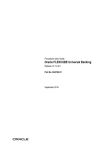

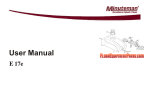
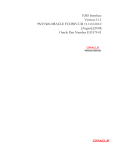


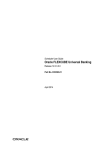

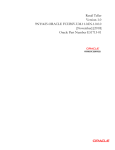

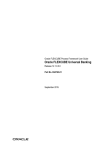

![[August] [2010] Oracle Part Number E51575-01](http://vs1.manualzilla.com/store/data/005654822_1-60fccbb787b73d73a8aa90efa0003782-150x150.png)
